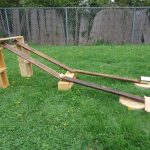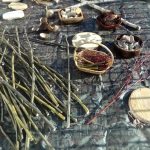As teachers in the early years, we are continually motivated to develop our expertise about developmentally appropriate practice. We look for ways to help young children make meaning of the world around them by supporting their innate curiosity and their tendency to explore their environments through play and discovery. Through this project, we attempted to foster a culture of inquiry by creating intentional play-based environments that are rich in open-ended materials. We wanted to promote learning that originated with student interests and evolved along with their questions and wonderings. Our focus was on outdoor learning as we recognize the importance of the outdoors in providing a rich multi-sensory experience for young children, as well as permitting a freedom of movement that is not available inside the classroom. We chose to explore the use of natural materials to promote inquiry because of our conviction that exposure to natural materials deepens children’s understanding of and promotes stewardship for the natural world. Because of their irregularities, varied textures and smells, natural materials provide a rich sensory experience to stimulate developing minds and are adaptable to many uses in imaginative play. We recognize the importance of inquiry skills as a vital competency for modern learners, as the ability to innovate and problem-solve is based on a foundation of inquiry.
Team Members
Emma Santangelo-Williams
Peel District School Board
John Kraan
Peel District School Board
Sherri Messier
Peel District School Board
Tanya Warfield
Peel District School Board
Nazish Naqvi
Peel District School Board
Professional Learning Goals
- Deepened our understanding of what inquiry looks like in kindergarten
- Developed our ability to use natural materials to create provocations in outdoor learning spaces
- Enhanced our skills around noticing and naming student learning by observing how they interacted with the materials and by listening to their conversations
- Found ways to uncover student growth as inquiry thinkers by asking intentional questions to promote sharing of their thoughts
- Developed ways to increase student capacity for demonstrating inquiry skills such as asking questions, making predictions and communicating observations
Activities and Resources
To provide materials for the children’s explorations, we purchased natural wood ramps and wooden balls, wooden dice and dominoes, Polydron building toys in natural colours, metal tins, glass mosaic tiles, and pottery clay. For additional loose parts, we gathered sticks, pine cones, log slices and rocks.
To develop our concept of inquiry, we consulted the THINQ Kindergarten resource. This was a starting point for discussion amongst our team. To find ideas for provocations, we used the following teacher resource books: Teaching STEM in the Early Years and STEAM Kids.
We created inviting spaces for exploration by arranging natural materials so that they were easily accessible. The children combined a variety of loose parts for many different purposes. We talked to the children as they played to encourage them to share their thinking. We asked questions and provided vocabulary to help the children explain their inquiry process and to help them uncover next steps in their investigations. To document their learning, we took photos and recorded their comments. We used our documentation both for teacher and student reflection, by sharing with the class during community circle. This was an opportunity to honour the children’s learning and it stimulated discussion that increased interest in the materials.
Unexpected Challenges
The main challenge that we experienced was around getting the children to express their thinking. There was a lot of sharing of observations, but very few questions. It was clear that their experimentation was motivated by their questions about the natural world, but the children had difficulty verbalizing them.
We also found that it was difficult to maintain student interest. When offering new materials to the children, there was a high level of interest, but it faded quickly. We feel that it is challenging to continually develop new provocations, as the variety of materials is limited by budgetary constraints.
Enhancing Student Learning and Development
Through this project the students enjoyed many opportunities to investigate and explore the world around them. They practised the process of inquiry by experimenting with natural materials, and they were guided by their own interests and wonderings. This afforded them the experience of rich learning in a developmentally appropriate manner. The students practised creative thinking and problem-solving as they worked to design and build structures, as they experimented with ramps, and as they found ways to represent their world using clay and loose parts. Many students practised co-operative skills such as taking turns, sharing materials and communicating their thinking as they worked together to plan and execute their inquiries.
When responding to intentional questions that illuminated their thinking, the children learned metacognitive skills that are crucial for deep learning. While consolidating their learning, this helped the children to plan ways to extend their investigations. Through the modelling of asking questions, the children developed skills around verbalizing questions that they had before and during their inquiries. Identifying the questions that form the catalyst for inquiry gave focus and direction to their investigations.
Sharing
Through team discussions and presentations at staff meetings, we are sharing our learning journey with our colleagues and administration. Through the use of the social media app, SeeSaw, we are communicating the children’s explorations and learning with parents. We hope that this will help parents to understand the importance of play-based learning and will encourage them to model and support inquiry at home.
Project Evaluation
This was a good opportunity for us to develop our understanding of inquiry in the kindergarten environment. By reading and discussing professional resources, we learned about the rationale for teaching with natural materials and learning in the outdoors. With renewed confidence in the value of this approach, we were able to create provocations for learning that encouraged inquiry. While observing students during their investigations, we identified ways to deepen their learning, and we identified areas where explicit teaching of inquiry skills would be beneficial. We feel that our learning from this project has increased our awareness of the need to support students during inquiry learning and strengthened our ability to provide supports.
We purchased many valuable resources for our outdoor classroom. The students enjoyed exploring and experimenting with open-ended materials and created amazing structures. We will continue to support students as they express their thinking using appropriate vocabulary.
We are looking forward to incorporating many more natural elements, such as water, wood chips and sand, into our inquiries now that the weather is becoming more favourable.
Resources Used
STEM PLAY Integrating Inquiry into Learning Centers (Authors: Deirdre Englehart, EdD; Debby Mitchell, EdD; Junie Albers-Biddle, EdD; Kelly Jennings-Towle, EdD; and Marnie Forestieri, CDA)
Teaching STEM in the Early Years (Author: Sally Moomaw, EdD)
THINQ Kindergarten: Inquiry-based Learning in the Kindergarten Classroom (Authors: Joan Reimer, Deb Watters, Jill Colyer and Jennifer Watt)
Resources Created
These resources will open in your browser in a new tab, or be downloaded to your computer.




